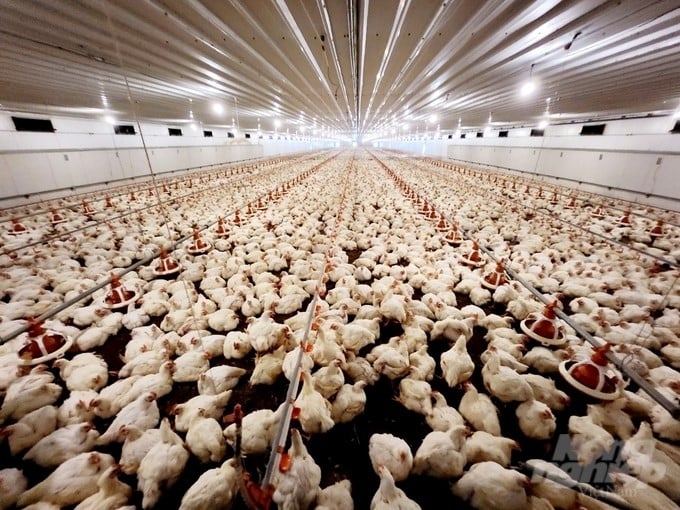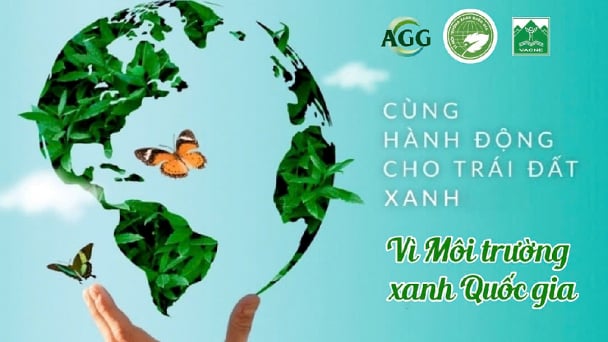May 19, 2025 | 03:00 GMT +7
May 19, 2025 | 03:00 GMT +7
Hotline: 0913.378.918
May 19, 2025 | 03:00 GMT +7
Hotline: 0913.378.918

Mr. Hoang Viet Chon, Deputy Director of the Thanh Hoa Department of Agriculture and Rural Development, worked with chicken breeding enterprises to discuss solutions for buidling a disease-free zone to serve export. Photo: Quoc Toan.
Thanh Hoa is one of the country’s top provinces in terms of large livestock herds, with a total of 180 thousand buffaloes, 270 thousand cows, 1.25 million pigs, and 24.5 million poultry herds bred at 1,080 farms and 739,355 farming households, and a lot of space and advantages left for animal husbandry development.
In recent years, the epidemic of livestock and poultry diseases has been well controlled. From 2022 until now, the province has not allowed the occurrence of African swine fever, avian influenza, and other dangerous infectious diseases, thus creating favorable conditions and building trust among businesses and breeders in animal husbandry investment and development.
At the beginning of 2023, many priority and large-scale livestock projects went into production, such as: the dairy cattle breeding project of TH Milk Company, which imported 1,500 dairy cows raised on the farm; the Xuan Thien Hi-tech Production and Breeding Complex Project, which imported 1,768 GGP pigs from Denmark; the DABACO Livestock Production Area Project, which imported 5,000 PS pigs from France; and the model of duck farming in Nong Cong district, which imported 36,000 ducks.

The chicken farm is certified as disease-free by 3F Viet Joint Stock Company in Thuong Xuan district, Thanh Hoa province, with a scale of 20 barns and a capacity of 2.4 million heads a year. Photo: Quoc Toan.
According to Mr. Dang Van Hiep, Director of the Animal Husbandry and Veterinary Sub-department, in the upcoming time, the animal husbandry of Thanh Hoa province will continue to develop high-tech and large-scale livestock production.
"In order to concretize the goal of implementing the Political Bureau’s Resolution 58 dated August 5, 2020 on Thanh Hoa province's construction and development to 2030, with a vision to 2045, and the Thanh Hoa Provincial Party Committee’s action program on the implementation of Resolution 58 of the Political Bureau and Resolution 19, dated June 16, 2022, at the Fifth Conference of the 13th Central Committee of the Communist Party of Vietnam on agriculture, farmers, and rural areas to 2030, with a vision to 2045, in the past, Thanh Hoa province has focused on promoting sustainable livestock production development by applying high technology, strengthening linkage chains, and linking abattoirs with large-scale farming households, in accordance with Resolution.
This is an important foundation for animal husbandry to continue the high-tech and large-scale livestock production development.
To accomplish this, animal husbandry will implement synchronous solutions, associate production with product consumption, and build disease-free areas and facilities, which is considered the key to developing the livestock industry in a sustainable way, serving domestic demand and export," said Mr. Dang Van Hiep.
Up to now, the province has built 104 disease-free breeding facilities, of which 61 pig breeding facilities have achieved disease safety with foot-and-mouth disease, classical swine fever, and African swine fever; four cow breeding establishments are safe from foot-and-mouth disease and Pasteurellosis; and 39 poultry breeding facilities are certified safe for avian influenza and Newcastle disease.
In addition, the Thanh Hoa Provincial People's Committee has issued a plan on building a rabies-free zone for dogs and cats in the city area, for the period 2022–2027, and a plan on building areas and facilities safe for African swine fever in Thach Thanh district, for the period 2022–2025, for the animal husbandry’s development.
According to Mr. Dang Van Hiep, in the upcoming time, in order to achieve the province's goal of developing large-scale and high-tech livestock production in a sustainable direction and meeting export requirements, the competent authority must continue to promote investment, work with large livestock production enterprises, processing businesses, export enterprises, and partners in domestic and foreign livestock products to call for livestock production investment and development in the province. At the same time, promote the construction of disease-free areas and facilities and build sustainable linkages in livestock to meet the export market.
According to the Department of Agriculture and Rural Development’s report, Thanh Hoa is one of the localities with the largest total livestock herd in the country. Currently, the livestock industry is moving in the direction of sustainable and high-tech production. In the past few years, a series of livestock projects with a total investment of up to tens of trillions of dongs in Thanh Hoa have helped animal husbandry affirm its position in the Thanh Hoa agricultural economy's development strategy.
It is worth noting that, from 2022 until now, the prevention and control of livestock, poultry, and animal diseases in Thanh Hoa have been well controlled and prevented dangerous infectious disease outbreaks, creating favorable conditions for the prevention and control of diseases and for the sustainable development of animal husbandry.
Translated by Huyen Vu Thu

(VAN) 14 out of 35 domesticated elephants in Dak Lak province have had their living conditions improved, with 11 of them currently participating in the non-riding elephant tourism model.

(VAN) Muong Nhe Nature Reserve hopes that being upgraded to a national park will lay the foundation for forest protection efforts to be carried out in a systematic, modern, and sustainable manner.
/2025/05/16/3923-2-171845_52.jpg)
(VAN) Lower costs, higher yields, and improved soil quality are outstanding benefits that soybeans bring when integrated into the crop rotation system.

(VAN) The 'For a Green National Environment' programme aims to promote a green lifestyle, support businesses in implementing ESG practices, and turn Net Zero commitments into concrete actions.

(VAN) Cold-barn systems efficiently manage environmental and temperature conditions, which aids in the prevention of respiratory diseases in pigs and protects them from the vectors that transmit African swine fevers.

(VAN) To tackle challenges, the project 'Addressing key technical bottlenecks in the grouper supply chain in Vietnam' has been underway since 2024.

(VAN) The project 'Disease-Resilient and Sustainable Cassava Production Systems in the Mekong Region', funded by the Australian Center for International Agricultural Research (ACIAR), is being implemented from 2024 to 2028.